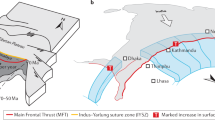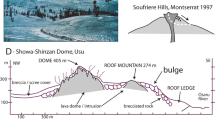Summary
Attaching himself to his earlier investigations, the author gives a new interpretation of mountain building and associated phenomena on the basis of his earth expansion theory. The geosynclinal phase of mountain building is connected with deep fractures accompanied by deep-sea troughs, isostatic anomalies and andesitic volcanism. On the other hand, the phase of emergence is accompanied by phenomena observable in the graben areas, which in their turn are connected with shallow-focus earthquakes and basaltic volcanism. Folding is brought about in and immediately after the geosynclinal phase by the lateral pressure of the intruding magma masses, and later on by the gliding by gravity of the accumulated sediments.
Zusammenfassung
Verfasser gibt, sich an seine früheren Untersuchungen anschließend, eine neue Deutung der Gebirgsbildung und der damit verbundenen Erscheinungen. Die geosynklinale Phase der Gebirgsbildung ist verbunden mit Tiefbrüchen, die ihrerseits von Tiefseerinnen, Tiefherdbeben, isostatischen Anomalien und andesitischem Vulkanismus begleitet werden. Andererseits wird die Phase der Heraushebung durch Ereignisse begleitet, die in grabenartigen Strukturen auftreten, z. T. durch Seichtherdbeben und basaltischen Vulkanismus. Die Faltung wird in der spätgeosynklinalen Phase und unmittelbar nachher durch den Raumanspruch der intrudierenden magmatischen Massen, in der Phase der Emporhebung jedoch durch die Gleitung (écoulement par gravité) der lockeren Sedimentmassen bedingt.
Similar content being viewed by others
References cited
Bemmelen, R. W. van: Beitrag zur Geologie der westlichen Gailtaler Alpen (Kernten, Österreich). Jahrb. d. Geol. Bundesanstalt,100, S. 179–212, 1957.
Carey, S. W.: The tectonic approach to continental drift. Continental Drift. A symposium. Tasmania, 1958.
Egyed, L.: A new theory on the internal constitution of the Earth and its geological-geophysical consequences. Földtani Közlöny,85, pp. 277–318, 1955 (in Hungarian); Acta Geol. Acad. Sci. Hung.,IV, pp. 43–83, 1956 (in English).
—: A new dynamic conception of the internal constitution of the Earth. Geologische Rundschau,46, pp. 101–121, 1957.
Egyed, L.: On the origin and constitution of the upper part of the Earth's mantle. Geologische Rundschau,50, pp. 251–258, 1960.
Hess, H. H.: Serpentines, Orogeny and Epeirogeny. Crust of the Earth. Geol. Soc. Am. Spec. Paper,62, pp. 391–407, 1955.
Heezen, B. C.: Géologie sous-marine et déplacements des continents. Colloques Internationaux du Centre National de la Recherche Scientifiue, No. LXXXIII, pp. 295–302, Paris, 1959.
Read, H. K.: Granite Series in Mobile Belts. The Crust of the Earth. Geol. Soc. Am. Spec. Paper,62, pp. 409–430, 1955.
Scheffer, V.: Über den Zusammenhang zwischen isostatischen Anomalien und Vergenzen der Gebirgsbildung. Acta Techn. Ac. Sci. Hung.,X, S. 19–29, 1955.
Trümpy, E.: Der Werdegang der Geosynklinalen. Geolog. Rundschau,50, pp. 4–7, 1960.
Author information
Authors and Affiliations
Rights and permissions
About this article
Cite this article
Egyed, L. On the mechanism of mountain building and folding. Geol Rundsch 50, 225–234 (1960). https://doi.org/10.1007/BF01786840
Issue Date:
DOI: https://doi.org/10.1007/BF01786840




